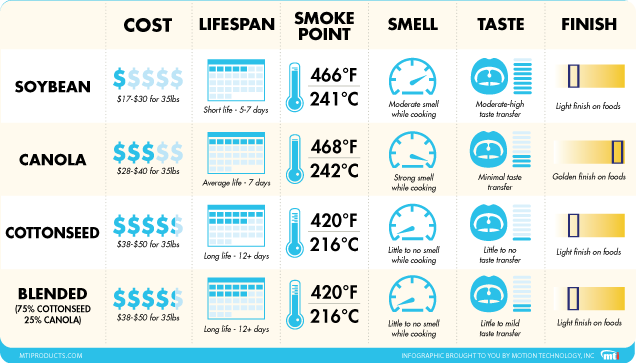Contact Us
1-800-348-2976
sales@mtiproducts.com
Ventless Revolution

Fryer Oil 101 - How, What, Why and Which
Fryer oil is one of the most common things people overlook when they cannot figure out why their food output isn’t as expected. And I’m not just talking clean or dirty fryer oil, obviously clean oil has a better output. But what about the type of oil you’re using, have you ever considered the implications that oil type has on your fried food? Probably not, which is why we’re dedicating today’s blog totally to fryer oil! We’ll cover all the basics like how frying works, what affects the life of your oil, how to tell when your oil is spent, how to get the most out of your fryer oil and which types of oil are recommended for frying in AutoFry.
How does Frying Work?
Let’s start with a basic understanding of how frying works: Food is added to hot oil and the surface of the food begins to dehydrate, this is seen through the bubbling of oil. The bubbles are actually pockets of water that are quickly vaporing and jumping out of the food. Meanwhile, the sugars and proteins in the food you’re cooking begin to breakdown from high heat, creating flavor and the golden brown color you’re used to seeing.
Why is that important to understand? Because the whole reason that frying works is because oil is hydrophobic (that old adage, water and oil don’t mix). The dehydration process necessary to fry foods is a result of oil's hydrophobic nature. But as your oil breaks down it becomes less hydrophobic and soon you’ll start to notice less bubbles. Ultimately, as the breakdown continues, oil starts entering your food too rapidly, causing it to turn greasy and ruining the crispness factor. Yuck.
What Causes the Breakdown of Fryer Oil?
The coating on your food and the food itself play a huge part in breakdown of oil. As a basic rule, the more particulate matter you introduce to oil and the finer those particles, the faster your oil will break down. Additionally frozen foods with lots of ice left on their coating cause more breakdown as they are added to the fryer, as you’re essentially adding food with a higher water content to expel (this can also cause oil pots to boil over, so check how much ice is on your food before throwing anything frozen into the chute).
Type of oil plays a huge part in the speed at which your oil breaks down as well. More expensive oils tend to be higher quality and have longer lifespan. But the biggest indicator in how quickly an oil will breakdown is its smoke point – or the temperature at which it begins to breakdown. The higher it is, theoretically the longer your oil will last. It’s important to know that each time you heat your oil you are reducing its smoke point. So if the first fry your oil’s smoke point is 420, next round it may only be 415, and after that maybe only 405. Once the smoke point drops to the same temperature at which you’re frying, you’ve got spent oil on your hands and it’s time for a refresh.
Storage of oil also plays a part in the breakdown of fryer oil, which is why AutoFry is such a beneficial machine to have on your team. Because it’s fully enclosed, light won’t have a chance to contribute to oil breakdown. Additionally keeping your AutoFry on standby mode during slow times keeps oil at a lower heated temperature providing a slower breakdown.
How do you Know Fryer Oil is Spent?
Actually we’ve got a whole blog on this topic, but as a general rule you can tell oil is spent by watching for these four things: smell – does your food smell burnt, how about the oil itself? Taste – do some quality control and taste your food frequently, does it taste fresh or does it have a stale flavor. If it tastes or smells off, toss it! Food color – keep an eye on the color of your food output, it should get darker the longer the oil is used, and at a certain point too dark indicates bad oil. Finally, smoke or “blue haze” - does your kitchen look a little hazy or smoky? That’s a sure sign of spent oil. For more info on the signs of spent fryer oil, click here.
How can you get the most out of your oil?
Filtering your fryer oil is going to be the biggest fryer life-saver. Filter as often as you can, we recommend at least daily filtering, but some locations (typically the higher volume stores) go the extra step of filtering after each day part. Cleaning your oil pot when you filter your oil is also going to make a big difference on the life of your oil. You can’t have totally clean oil if you put it in a dirty pot, so clean and filter at the same time (for more on that subject check out this link). And finally, as mentioned before, keeping the machine on standby instead of full heat when you’ve got down time is crucial to extending oil life.
Types of Oil
So now that you know the basics about how frying works, how fryer oil breaks down and how to extend its life, let’s look at some of your oil options. Most common across the board and the four types that we highly recommend for AutoFry are Soybean, Canola, Cottonseed and a Cottonseed-Canola blend. These four oils all have smoke points of 420 or higher, so generally they will last at least 5-7 days in your fryer, although some will last longer.
Soybean and canola are going to be your smelliest options when it comes to the fried food scent you get when deep frying. Even though AutoFry is fully enclosed and ventless with its own set of filters, it is not 100% odor free. While the enclosure of the fryer takes away much of the fried smell, some odor can release from the entry and exit chutes. If odor is a concern for you, stick to cottonseed or a cottonseed blend which has nearly no scent.
Additionally cottonseed and the canola-cottonseed blend have an average life of 12 days, where soybean and canola only have an average life of one week. That said, they are typically higher priced oils as they are marketed as upgraded fryer oil. Moreover, their smoke points are lower than that of soybean and canola, so you cannot cook with as high of heat.
As you can see, each oil has its own set of pros and cons, so we made this handy chart for you to reference when deciding on which oil you plan of cooking with.
Now is also probably a great time to mention our friendly service department who are also skilled in all things AutoFry, including helping you to make the best oil choice for your needs. So if you’re still feeling unsure about oil, don’t hesitate to give Matt or Mike a call for oil advice at 800-348-2976.


